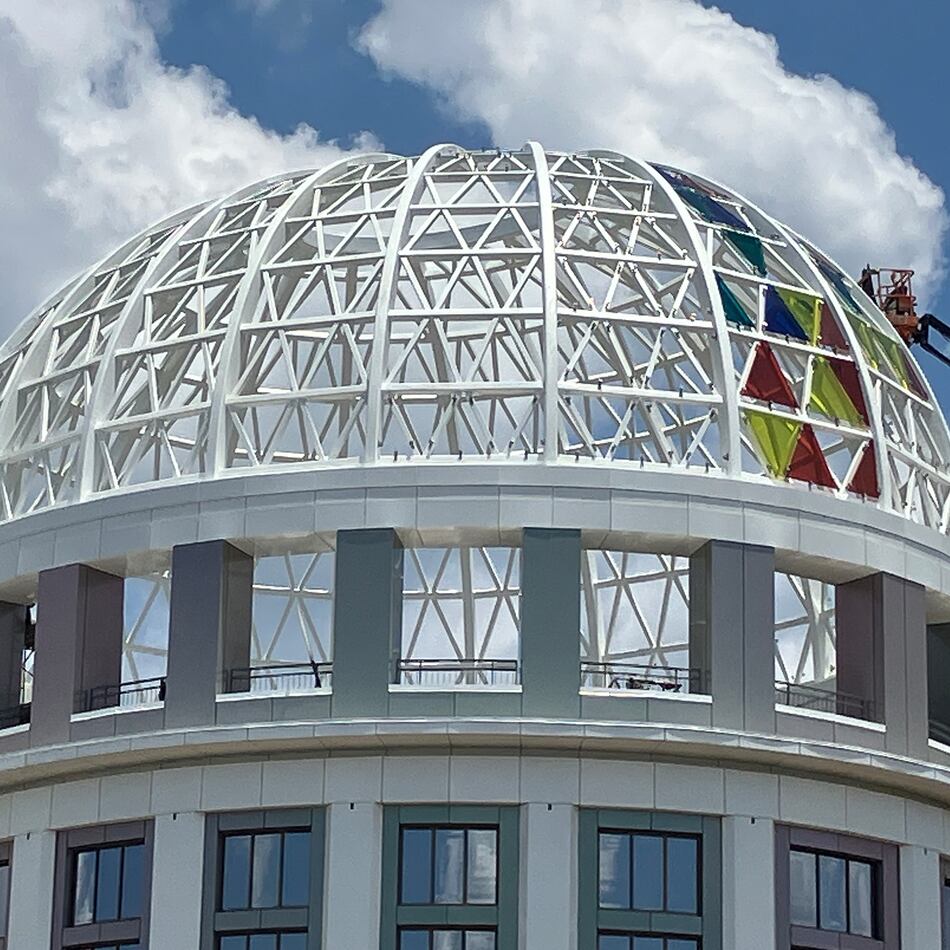This story was originally published by ArtsATL.
The most exciting news in Atlanta’s art world this year was the announcement that the city’s first Art Fair will take place in October 2024, in conjunction with the third annual Art Week.
Photography was big in 2023. We saw powerful photography exhibits the High Museum of Art, the Michael C. Carlos Museum, the David J. Sencer CDC Museum and Jackson Fine Art, which opened a sleek new gallery in the spring.
Atlanta Celebrates Photography rebranded as Atlanta Center for Photography, hired a new director and opened a gallery on Edgewood Avenue, while Atlanta Photography Group appointed David Clifton-Strawn as executive director.
In other news, UTA Artist Space Atlanta opened its permanent gallery in Midtown in January with a Lonnie Holley exhibit. The PATH Museum opened this summer in Buckhead: Work by the late Larry Walker was featured there and at Mason Fine Art. Jane Jackson, founder of Jackson Fine Art, opened a new venture, the Object Space, sharing space with Sandler Hudson Gallery on the Westside.
The Spelman College Museum of Fine Art launched its first national traveling exhibit. “Silver Linings: Celebrating the Spelman Art Collection” features work by almost 40 artists of African descent. The tour commenced at Vassar College in September and will travel to four more museums in 2024.
Milestones: Atlanta Contemporary celebrated its 50th anniversary, Hammonds House its 35th. Art Papers announced it will cease publishing in 2026 (its 50th anniversary.) Executive director Veronica Kessenich left Atlanta Contemporary and the city mourned the loss of Radcliffe Bailey as well as Walker.
It’s never easy to create a best-of round up -- there are sure to be some deserving exhibits that don’t make the list -- but our art writers Jerry Cullum, Stephanie Dowda DeMer, Cinqué Hicks, Angela Oliver, Louise E. Shaw, Deanna Sirlin and Virginie Kippelen have done their finest, below.
::
Credit: Handout
Credit: Handout
Independent of its ambitious theory about common elements among contemporary African American artists, Johnson Lowe Gallery’s exhibition ”The Alchemists” (March and April) was produced at a level of risk and expense that almost no other Atlanta galleries could venture to approximate. Combining gallery owner Donovan Johnson’s curation with that of New York critic and curator Seph Rodney, “The Alchemists” brought works by internationally known artists not represented by the gallery into conversation with works by its Atlanta-based artists. It took the added risk of a panel discussion in which the keynote speaker took partial issue with the exhibition’s chief thesis. -- JC
::
This iteration of Georgia Women to Watch, ”New Worlds: Georgia Women to Watch” at Atlanta Contemporary (February through May) exceeded expectations. Curated by Melissa Messina and Sienna King, “New Worlds” was birthed during the pandemic from 16 studio visits to women-identifying artists across Georgia. The curators asked this existential question: When women artists envision a different world, how does that look? Although the intensity of the Covid-19 experience is in the rear-view mirror, we should remember that the pandemic was a time for reflection. Ultimately, five artists were chosen. To further structure the exhibition, the curators selected installation-based works informed by the female experience, all thoughtfully installed in conversation with one another. --LES
::
Credit: Courtesy of Science Gallery Atlanta
Credit: Courtesy of Science Gallery Atlanta
”Justice” at Science Gallery Atlanta (March through September) highlighted interdisciplinary collaborations among artists, scientists, thinkers and activists in dialogues about social justice issues including structural racism and the impact of gentrification. In terms of scale, Atlanta-based artist Sanithna Phansavanh’s installation dominated the space by wrapping a MARTA bus with a flora and fauna design questioning the planet’s ecological future. For Freedoms, a national collective of politically active artists, contributed billboards and posters with social justice messages. The exhibition was further activated by interactive installations and participatory events, including a coffeehouse where the global implications of coffee production were explored. I have great expectations for what comes next. -- LES
::
”Close to the Edge: The Birth of Hip-Hop Architecture,” at the Museum of Design Atlanta (MODA) for seven months, was a stand-out exhibition among the plethora of offerings celebrating the 50th anniversary of the birth of hip-hop and featured the work of 34 participants from across the globe. Curator, architect and exhibition designer Sekou Cooke organized the traveling exhibition that masterfully integrated the gestalt of the hip-hop movement with exhibition design built upon repurposed shipping containers. Channeling hip-hop energy and the urban experience, the featured projects included experimental visualizations, installations, building designs, urban development proposals and, of course, a playlist. MODA expanded the exhibition’s content and design vocabulary with significant Atlanta content. -- LES
::
”Black American Portraits,” on view at Spelman College Museum of Fine Art in the summer, was one of the most intelligent, ambitious and wide-ranging exhibits of Black American subjects in perhaps a generation. The exhibit originated at the Los Angeles County Museum of Art, and 113 of the 140 works in that show were in the Spelman exhibit, together with four additional works. The exhibit encompassed more than 200 years of portraiture in the visual arts, mostly by Black artists, including two dimensional, three dimensional and time-based media. These works provided an important counterbalance to pervasive images of Blackpain by celebrating sexuality, political achievements, the Harlem Renaissance and, simply, Blackjoy. -- CH
::
Credit: Courtesy of Clint Fuller
Credit: Courtesy of Clint Fuller
”Every Stage of Becoming,” Jessica Caldas’ exhibition at MOCA GA in June and July, was an emblematic visual manifesto on being a mother, a daughter and a woman. The life-size domestic tableaux in which her sculptures appeared were theatrical. As in a medieval processional play, the viewer moved from one station to the next as the narrative built. The mother was the main character, the hero of the artist’s narrative. Through references to female giants of Greek mythology, Caldas analogized the artistic process with birthing, caring, mothering and the physical pathos of the female body. It was impossible not to feel the pathos of the exhaustion of these female forms whose elongated legs and pillow-like bodies became a metaphorical bed on which to rest the weary vessel of the female body. -- DS
::
The word “renaissance” this year has seen quite a . . . well, renaissance, thanks to Queen Bey. But it’s nothing new for one Los Angeles-based artist for whom Renaissance-era art is a muse. Rich brown skin covered the bodies in Harmonia Rosales’ stunning ”Master Narrative,” a traveling exhibit at the Spelman College Museum of Fine Art (August through November). A reimagining of the Sistine Chapel ceiling and an ode to the Yorùbá gods of West African spiritual traditions, it reflected her own journey to self-love as an Afro-Cuban woman. With its centering of Eve as an ancestral collective, it also reflected the resilience of those traditions -- once lost in and muddied by Atlantic waters, now retrieved by innate recollection and, ultimately, one’s understanding of the God within. -- AO
::
Hasani Sahale’s “You Really Got to See It Live” was the highlight of Atlanta Contemporary’s 50th anniversary fall exhibitions. (Disclosure: from 1983-1998, this writer was executive director of Nexus Contemporary Art Center from whence the Contemporary evolved.) Embodying the institution’s historic commitment to supporting and presenting rising artists from and of Atlanta (think Radcliffe Bailey and Kara Walker), the exhibition was a thrilling presentation of Sahale’s recent monumental paintings that balance formal issues of abstraction and the physicality of paint and painting with a personal vocabulary that references the artist’s Caribbean upbringing and the African diaspora experience. -- LES
::
Credit: Gordon Parks
Credit: Gordon Parks
Artists in the South have long desired a smart, curious and comprehensive curation of the complexities of making work in a region often on the edge of understanding. That exhibition finally opened at the High Museum of Art in September and runs through January 14, 2024. “A Long Arc: Photography and the American South Since 1845″ is by far the most illuminating, comprehensive and important exhibition of 2023, featuring a range of remarkable Southern photographs. In addition to the impact on understanding Southern artists, the exhibition is a bridge to understanding the South and thus ourselves -- both for insiders and outsiders. Further, “A Long Arc” is easily the most important exhibition on photography in years, anywhere. -- SDD
::
For months this fall, Kennesaw State University’s Zuckerman Museum of Art took visitors beneath the surface of Caribbean cultures in ”{UNDER}flow,” an exhibition featuring five worldwide Afro-Caribbean artists. A fusion of history and legend, bloodlines and chosen family, and the vibrance of pop culture amid the shadows of solitude, “{UNDER}flow” was a wandering tale of identity, sexuality, perception and the piercing return of the gaze on Black bodies back to the viewer. The depth of each story was only outdone by the aesthetic beauty of the art -- among the most dazzling this year -- and technical mastery of each piece. The exhibit gave birth to extensive educational programming and a collaboration with the Haitian Studies Association’s 35th annual conference hosted by Morehouse College. -- AO
::
Credit: Handout
Credit: Handout
The Michael C. Carlos Museum is not known for photography exhibits. But ”You Belong Here: Place, People and Purpose in Latinx Photography,” on view at the museum September through November, was designed to attract a different kind of art lover, those more in tune with contemporary issues. Curated by Pilar Tompkins Rivas, under the auspices of the nonprofit Aperture, the images were thought-provoking, offering a rich visual experience that helped remediate a lack of visibility for this multifaceted community. It featured the work of 16 photographers, all different in their photographic approaches, but whose work collectively created a comprehensive and nuanced vision of Latinx communities. -- VK
::
Photographer Rich Frishman’s ”Ghosts of Segregation,” on view until May 24, 2024, at the David J Sencer CDC Museum, explores brilliantly the lingering presence of segregation and institutional racism hidden in the American landscape. Some of the sites he photographed have entered our collective consciousness but many everyday places such as movie theater entrances, ice cream parlors or railroad hotels, have remained invisible or simply forgotten. Frishman searched tirelessly for clues in the built environment to unearth the visible, but easily overlooked, signs of an ugly past. His intention is clear: to “heighten awareness, motivate action and spark an honest conversation about the legacy of racial injustice in America.” -- VK
::
At the intersection of art and community lies ”We Are Each Other,” Sonya Clark’s evocative ride through shared humanity that continues at the High Museum of Art through Feb. 18, 2024. A survey of the multidisciplinary artist’s participatory projects spanning 25 years, it confronts racism by not only celebrating the art and endurance of Black culture -- from hairstyles to Gwendolyn Brooks’ “Paul Robeson” poem, the inspiration for the exhibition title -- but also by calling out the long-lived delusion of White supremacy that permeates this country’s soil and systems. Clark’s work challenges viewers to take part in dismantling that with their own hands. “We Are Each Other” is a story of survival, where, even after gut-wrenching lifetimes of despair, hope remains. -- AO
Credit: ArtsATL
Credit: ArtsATL
MEET OUR PARTNER
ArtsATL (www.artsatl.org), is a nonprofit organization that plays a critical role in educating and informing audiences about metro Atlanta’s arts and culture. Founded in 2009, ArtsATL’s goal is to help build a sustainable arts community contributing to the economic and cultural health of the city.If you have any questions about this partnership or others, please contact Senior Manager of Partnerships Nicole Williams at nicole.williams@ajc.com.
About the Author
Keep Reading
The Latest
Featured







